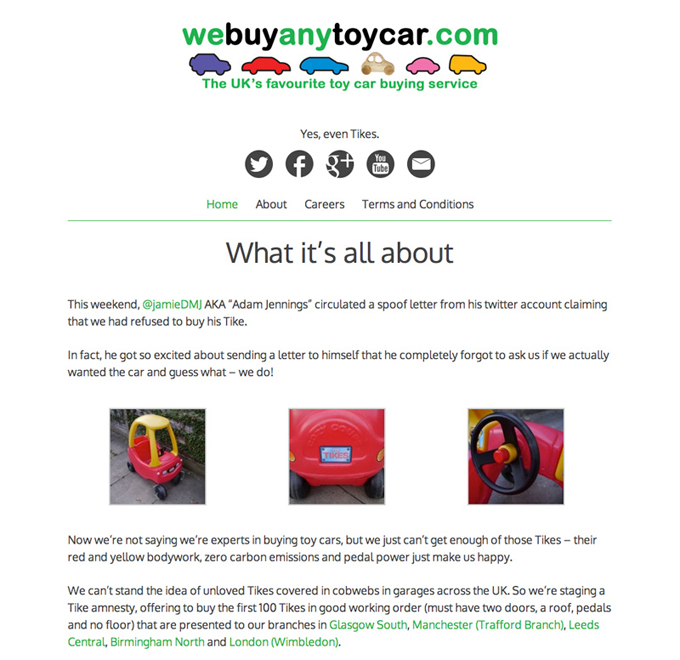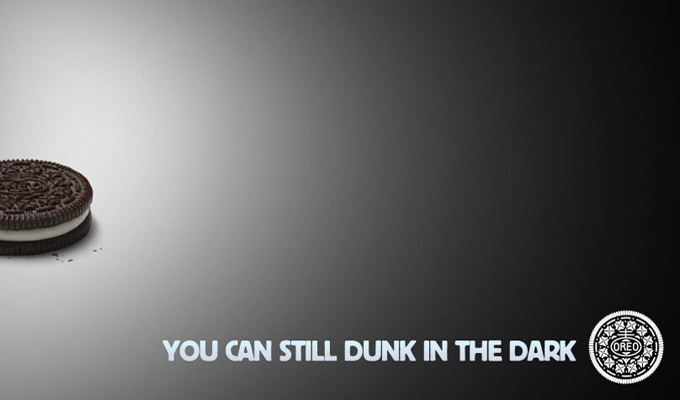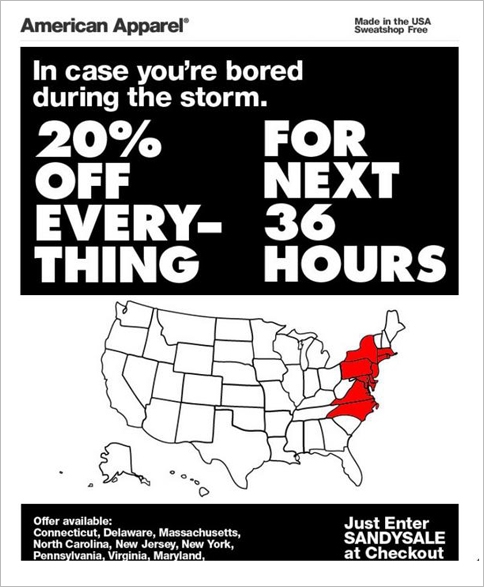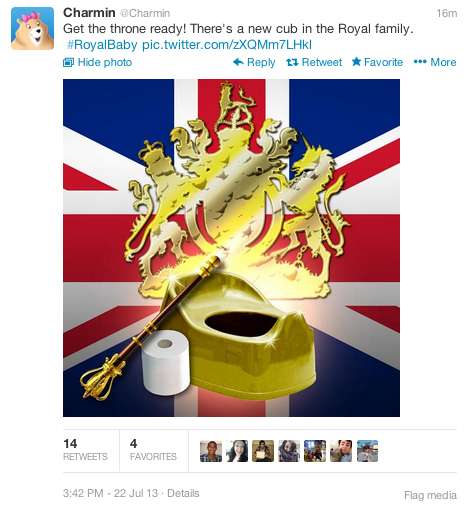Yesterday, WeBuyAnyCar.com, the used car website, demonstrated excellence in timely and authentic responsive marketing. At the weekend twitterer Jamie Jones (@jamieDMJ) (and, as it turned out, aka Adam Jennings) tweeted a photo of a letter purported to be from WeBuyAnyCar in which the company declined to buy his “Little Tikes” toy car. The letter turned out to be fake, but not before it had gone viral (32,000+ retweets). The brand saw the funny side, and yesterday, one-upped the prankster by launching the website WeBuyAnyToyCar.com in which it offers to buy the first 100 of the miniature “vehicles” for £10, with the proceeds going to road safety charity Brake.
The spoof site, devised by Democracy PR, also announces a new job opening — Junior Vehicle Purchaser (“will involve inspecting Tikes (for bumps and jam stains)… Hours: Monday – Wednesday (after school)”). The fun stunt is extremely responsive, and very “on brand” — those who remember the early TV ads with their annoyingly memorable song and high energy dance routines will know the company has a sense of humour. The campaign also gets additional brownie points for the charitable aspect, plus makes use of new social media darling, Vine, for the new brand’s “TV advert”. In my opinion, it’s a text book example of how to do responsive marketing right.

Business owners and marketers often hear that, in the modern age, marketing — and social media marketing in particular — needs to be timely and relevant. Responding to events, or listening to your customers, demonstrates that you’re culturally aware and engaged with your audience. But being responsive is not an easy task, and it’s all too easy, even for big brands, to come unstuck when trying to take advantage of things as they happen. For every Oreo’s Superbowl success story there is an AT&T 9/11 backfire. So how do you produce responsive marketing which delights rather than displeases?

Be timely
In the words of Ferris Bueller, the World moves pretty fast, and if you take too long to react to something, you may miss the boat entirely. Earlier this year, the internet was overrun by the Harlem Shake meme. Many organisations, a number of charities amongst them, tried to jump on the bandwagon, but by the time many had got their videos together, it was weeks after the craze peaked. The effect? It was a bit like watching a forty-three year old man trying to pull off a pair of bright pink skinny jeans — you admired them for trying to stay current, but it actually reinforced how out of touch they were. When internet memes are being written about in newspapers, they’re old news. Act quickly. WeBuyAnyCar responded in just two days with a well thought out, and integrated, bit of creative.
Think carefully
But don’t act so quickly, you go off half-cocked. If you don’t think things through you could end up inadvertently offending some people, like American Apparel and Gap did around this time last year with their Hurricane Sandy promotions — that’s right, they used a violent storm in which people died as a vehicle to try and sell stuff. You might think that anyone would see using a natural disaster to promote a sale as a bad idea, but sometimes even a well-meaning gesture can be quickly condemned as crass. The Golf Channel may have had a genuine desire to celebrate the 50th anniversary of Martin Luther King’s “I have a dream” speech, but trying to tie in dreaming about a better golf swing was ill-conceived.

That doesn’t mean you should avoid controversy entirely, but you have to be aware of the risks. A good rule of thumb is that if the event you’re looking to associate your brand with stirs up very strong feelings, or may result in injury, death, or destruction, it’s probably a good idea to walk away from it — a lesson Kenneth Cole learned the hard way. The WeBuyAnyToyCar.com campaign avoids any ill-feeling by being light-hearted, and being associated with Brake.
But don’t over think
Spending too much time thinking things through could kill inventiveness. The birth of Prince George this summer resulted in numerous examples of companies that clearly spent far too long planning a “timely” response. The result was that, whilst a few hit the mark, many came over as contrived and a bit desperate. Over-planning can be the death of creativity, and if you have to stretch to make a connection between an event and your brand, it’s probably a connection that shouldn’t be made. What made the Oreo Superbowl tweet work was that no one saw the blackout that prompted it coming — it was a genuinely quick response to something as it happened, and the creative fit with the brand. The same goes for WeBuyAnyToyCar.

Be genuine
Another phrase often bandied about is “be authentic”. But what does authenticity in marketing mean? Does it mean we should just put up ads with the words “please buy our stuff because we need to make money”? It would be authentic, but not likely to win you much business — though some may reward you for your honesty. Authenticity in our book means that it needs to be genuine — true to your brand and audience. Don’t try to be something you’re not, or to hide who you are.
It also means show some personality. There is a recurring debate about whether brands can have personalities — one I’m not going to dig into here — but the employees, owners, and directors of companies certainly do (well, at least most of them do). Allowing consumers to get a sense of the people behind the brand is a good thing (provided we don’t hate them). We don’t build emotional attachment to faceless corporations, we create bonds with companies that seem to share our values, our concerns, and even our sense of humour. Those things are very often communicated by the people — think Steve Jobs, Gary Vaynerchuck, Karl Lagerfeld, that woman from BT Customer Service who took your call last week.

One of my personal favourite Twitter accounts for genuine, but sometimes bizarre, personality is Waterstone’s Oxford Street (@WstonesOxfordSt). The account is managed by staff, breaks many “rules” of business twitter (such as number of tweets per day), and frequently uses the medium to tell short, occasionally outlandish stories in 140 character instalments — which couldn’t be any more appropriate for a book store. Another well-known personality filled account is the one for Taco Bell (@TacoBell).
Have fun
Which brings me to my last point. If possible, make it fun. Some of the most effective responsive marketing has humour or a sense of fun at its core. This is certainly the case for WeBuyAnyToyCar, but also many other successful responsive campaigns. One of my favourites from recent years is the “Bodyform Responds: The Truth” video (see below) made in response to a Facebook post.
Of course, if you’re a charity trying to draw attention to the plight of refugees from the war in Syria, making light of the situation is not going to win you many fans, but as Comic Relief has shown, balancing earnest efforts to tackle live and death problems with entertainment can be done. WeBuyAnyToyCar is a fun stunt, but that doesn’t prevent a hint of seriousness in the support given to a road safety organisation.


